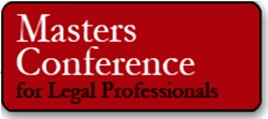Masters Conference DC, Day Two: eDiscovery Trends
As we indicated yesterday and Monday, The Masters Conference has been going on in Washington DC! Today’s the last day! Let’s take a look at today’s events!
The conference is being held at the Capital Hilton, 1001 16th St NW, Washington, DC 20036. Registration begins at 7:30am again today, with sessions starting at 8:30am.
Here is the list of today’s sessions:
8:30am – 9:30am:
Multiple Strengths, One Goal: Building Rock Star Diverse Teams
Moderator: Zelda Owens, CSSGB, Panelists: Aaron Crews, Debbie Reynolds, Mary Ellen Connerty, Monica Bay
Moving from Models to Standards: Next Steps in Maturing the Industry
Moderator: Eric P. Mandel, Panelists: Eli Nelson, Kevin Clark, Sunil Ohri, Tara Emory
9:45am – 10:45am:
The Five Forces Impacting Corporate eDiscovery: Five forces on how to save corporations money, locate your documents quicker, make fewer mistakes and make you look like a star. This panel discusses practical ways to leverage technology so you can do more of what you do best as a lawyer. Learn to trust the technology to make you more efficient and more profitable.
Moderator: Adam Kuhn, Panelists: Aaron Crews, Ethan Ackerman, Michael E. Lackey, Neguiel Hicks
FRCP: Amendments to the Federal Rules of Civil Procedure: The Early Returns: This presentation will review the proposed changes to the FRCP, including e-Discovery conduct, insight into how federal judges are already thinking about the changes, and how to adjust your current and future litigation strategies and e-Discovery processes in light of the proposed amendments. The legal community will definitely be altered in the coming years as a direct result of the FRCP alterations. Get the jump on any surprises with this informative and interesting presentation.
Moderator: Ralph Colby Losey, Panelists: Cheryl A. Feeley, David Kinzer, Jennifer A. Brennan
11:00am – 12:00pm:
Revealing the New Privacy World of the EU/US Privacy Shield and the GDPR
Moderator: Evelyn Minnick, Panelists: James Daley, Nikos Leoutsarakos, Paul A. Meyer.
“Seeing is believing” – How Video is Changing the Way We Win Cases
Moderator: Ian Campbell, Panelists: Chad Papenfuss, Deena Coffman, Robert DeBord, Susan Taylor.
12:15pm to 1:35pm:
Explore today’s best practices for investigations, ranging from internal investigations to highly complex regulatory investigations
Moderator: Krista Fuller, Panelists: Aaron Crews, Antonia Rahneva, John Rosenthal, Thomas Matzen.
1:45pm – 2:45pm:
Latest Cybersecurity Trends in Government
Moderator: James Bourie, Panelists: Allison Bender, Donald Codling, Justin Zeefe.
Faster, Bigger, Better eDiscovery: Leveraging Technology to its Fullest: As the volume of information grows, corporations are pushing outside counsel to find cheaper and more efficient ways to handle eDiscovery. However, today’s litigation is too often forged without a master plan – plagued by errors, delays and unnecessary expense. What’s needed is a more streamlined, systematic approach to curb the drain on time and resources that eDiscovery has become. In this session, industry experts will address how to best leverage a variety of technologies to help drive down client costs and increase productivity.
Topics include:
- TAR and leveraging analytics
- Unique file redactions
- The future of technology in eDiscovery
Moderator: Bruce Markowitz, Panelists: Antigone Peyton, Oral Pottinger, Paul A. Meyer, Robert D. Keeling.
3:00pm – 4:00pm:
Cybersecurity: and in House perspective: Join two top in-house lawyers. To hear about how they address top cybersecurity issues internally and externally.
Moderator: Christina Ayiotis, Panelists: Hilary Hageman, Michelle Beistle.
Streamline eDiscovery Workflows that Deming would Love
Moderator: Tammy Doss, Panelists: Allison Stanton, Nick Carter, Shea Leitch
4:15pm – 5:15pm:
JUDGES PANEL
Panelist: Hon. Ronald J. Hedges.
There will also be a happy hour at 6pm “focused on enjoying and reflecting on the next 10 years”.
So, what do you think? Did you attend The Masters Conference this week? If so, what did you think? And, as always, please share any comments you might have or if you’d like to know more about a particular topic.
Disclaimer: The views represented herein are exclusively the views of the author, and do not necessarily represent the views held by CloudNine. eDiscovery Daily is made available by CloudNine solely for educational purposes to provide general information about general eDiscovery principles and not to provide specific legal advice applicable to any particular circumstance. eDiscovery Daily should not be used as a substitute for competent legal advice from a lawyer you have retained and who has agreed to represent you.








